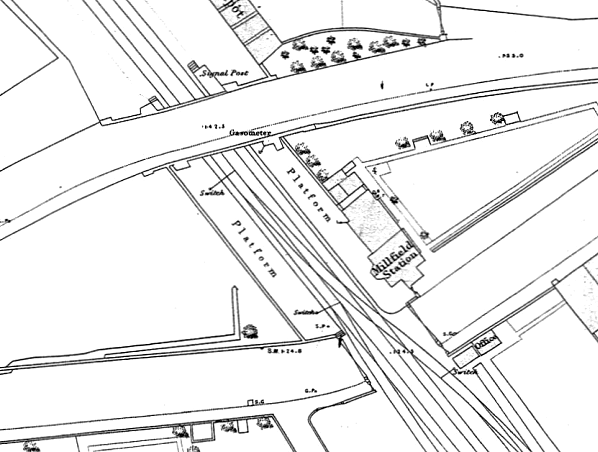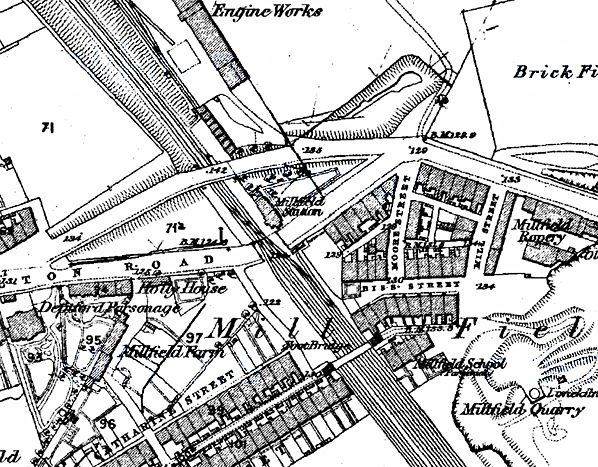
Station Name: MILLFIELD (1st site)
|
| Date opened: | 1.6.1853 | |
| Location: |
|
|
| Company on opening: | York, Newcastle & Berwick Railway | |
| Date closed to passengers: |
|
|
| Date closed completely: | Goods facilities retained until at least 1978 | |
| Company on closing: | North Eastern Railway |
|
| Present state: | Demolished | |
| County: | Durham (now Tyne & Wear) | |
| OS Grid Ref: | NZ385571 | |
| Date of visit: | 20.6.2013 |
Notes: Millfield station opened with the Leamside – Sunderland route in 1853. At that time the streets and industries of Sunderland had sprawled westwards in a haphazard fashion, and a limb of urban development stretched out as far as Millfield; there was still a tract of countryside between the town and Millfield station, and beyond it the land was largely rural, but with pockets of industry. Immediately north-west of Millfield station was an engine works reached from the west by a siding on the down side of the line. By the last decade of the century streets of terraced housing had engulfed the line from Sunderland to Millfield. The original site of the station was immediately north-west of the Hylton Road crossing, but the road was later diverted to a bridge over the railway immediately north-west of the station. The station building was on the down (Sunderland-bound) platform. It was a two-storey house, gable end-on to the railway with a canted bay window abutting the platform ramp and then a range continuing north-westwards, stepped back along the platform. Some dignity was given to the building by a generous roof overhang and the use of stone quoins. Fawcett suggests that the building originally had an attic-style first floor, later raised to full height, evidence being in the differential weathering of the bricks. It is not clear from Ordnance Survey plans what buildings were provided on the up platform. In February 1863 Bradshaw shows eight weekday calls by up trains on weekdays and three on Sundays. In the opposite direction there were seven on weekdays and three on Sundays. By summer 1896 the service had increased to 10 up on Monday-to-Friday, 11 on Saturdays, but still three on Sundays. Down train calls amounted to 12 on Monday-to-Friday, 13 on Saturdays, and four on Sundays. Three of the down weekday trains called by request to set down passengers from stations south of York. By this time Millfield had a new station on a new site.
From 1857 Leamside station enjoyed some importance as the de facto junction where trains to and from Sunderland and Durham connected with the services on London Kings Cross – Newcastle – Edinburgh main line. Fencehouses or Penshaw could equally have been awarded this status, but Leamside station, in its remote rural surroundings, was rebuilt with an island platform and bays at each end to accommodate the connecting services and allow convenient interchange by passengers. Its importance was short-lived and was suddenly removed when the new main line route between Ferryhill and Newcastle via Durham opened in 1872. Leamside station was now an extravagance, with little local population to serve; conversely the splendid Durham viaduct, originally serving only the Leamside – Bishop Auckland branch, was now a prominent feature of the main line providing a vantage point from which millions of passengers would be able to admire Durham and its cathedral. As with most lines in northern County Durham the Sunderland – Durham route carried large quantities of goods and mineral traffic, notably coal. Several collieries were directly linked to the line, and there were branches into shipyards and Deptford staiths on the Wear as well as to the Hudson, Henson and South docks on the coast. Passenger services on the Sunderland – Durham line remained frequent. However from the 1920s motor buses began to provide a more intensive service and linked the numerous mining villages and towns in north-east Durham. The ‘Old Main Line’ south of Leamside lost its passenger services in 1941. On the Sunderland – Durham route, apart from the very early loss of Frankland station, between Leamside and Durham, in 1877, casualties began with Leamside in 1953, followed by Millfield in inner Sunderland in 1955. Diesel multiple units replaced steam haulage on the route during 1957. he author was blissfully unaware of this development, and alighted from a Newcastle train at Durham on 15 May to catch the Sunderland train, only to be informed that the last one had gone! He decided to travel on to Darlington and Middleton-in-Teesdale instead – which was still open. Goods services ceased between Leamside (Auckland Junction) and Durham (Newton Hall Junction) and at Finchale siding (Frankland) on 22 October 1964. The tracks into the former Fawcett Street terminus in Sunderland, which had continued as a goods facility reached from the Durham line, were severed on 3 October 1965. Goods services were retained between Penshaw and Sunderland until 21 August 1967 when they were discontinued west of Hylton Quarry sidings. In 1971 the line from Pallion to Ford paper works at Hylton was singled and ceased to be signalled when the factory closed, but Dolomite from Hylton Quarry continued to be carried until 1976 when the line was cut back to Pallion; it was officially taken out of use on 20 November 1976. The remainder of the line to Hendon, including Deptford Johnson Siding closed to goods on 27 November 1984. The section of the ‘Old Main Line’ which the Sunderland – Durham services shared between Penshaw Junction and Auckland Junction continued in goods use for some years more, but was ‘mothballed’ in 1991 and closed in 2012.
Bradshaw from Chris Totty. Route maps drawn by Alan Young. To see other stations on the Old Main Line click on the station name: Felling 2nd, Felling 3rd See also Sunderland and Durham (via Leamside): |
first_old2.jpg)


first_old3.jpg)
Photo by Brian Johnson
first_old1.jpg)
Photo by Roy Lambeth
first_old4.jpg)
Photo by JM Fleming
first5.jpg)
Photo by Alan Lewis from his Ipernity photo gallery
first6.jpg)
be extended and restored.
Photo by Alan Lewis from his Ipernity photo gallery
first8.jpg)
Photo by Alan Lewis from his Ipernity photo gallery
first9.jpg)
Photo by Alan Lewis from his Ipernity photo gallery
first12.jpg)
Photo by Alan Young

| Last updated: Sunday, 21-May-2017 15:41:04 CEST |
© 1998-2013 Disused Stations
|


thumb6.jpg)
thumb7.jpg)
firs_thumb7.jpg)
first_thumb11.jpg)

 Home Page
Home Page